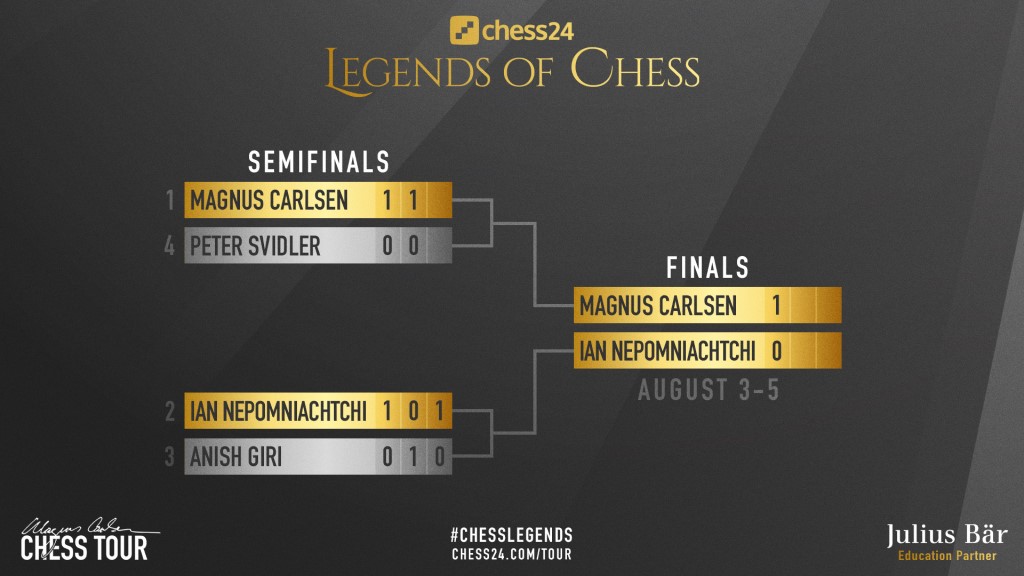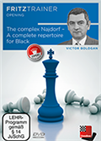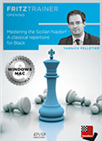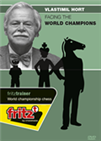Twelve sets in a row
Beating Magnus Carlsen has proven to be all but impossible during the series of online tournaments that bears his name. During the ‘Legends of Chess’, he is yet to lose a single mini-match, and if he wins again on Tuesday, he will have achieved a perfect 13-0 record throughout the event. Moreover, this will be his third tournament win in the series — out of 4 events! (He was eliminated in the semis of the Lindores Abbey Rapid Challenge by Hikaru Nakamura, and that tournament was won by Daniil Dubov).
So how can his rivals approach facing such a dominant force? Ian Nepomniachtchi’s solution was to look for sharp continuations every chance he got. Of course, Carlsen had to comply, and that is exactly what he did. As Ivan Sokolov shared on Twitter:
Wondered why Magnus entered this risky line. Maybe he cares about us and wants to give us some entertainment.
That is a possibility, although it is completely feasible that Carlsen simply thought that was what he needed to do to keep on winning. Or maybe both. Whatever the motivation, the Norwegian continues to show why he is already being compared with the greatest of all time.

Click to enlarge
Game 1: Ups and downs
The players set the stage for the kind of fight that would be seen in games 1, 3 and 5, entering a full-fledged battle in the Sicilian:
 When choosing an opening repertoire, there are days when you want to play for a win with Black, when you want to bear down on your opponent’s position with a potentially crushing attack. The Najdorf is perfect for just such occasions. Strategy, combinations, attack and defence, sacrifices and marvellous manoeuvres — exciting chess is all about the Najdorf!
When choosing an opening repertoire, there are days when you want to play for a win with Black, when you want to bear down on your opponent’s position with a potentially crushing attack. The Najdorf is perfect for just such occasions. Strategy, combinations, attack and defence, sacrifices and marvellous manoeuvres — exciting chess is all about the Najdorf!
Except the fact that he played 6.h3 instead of 6.Rg1 in game 5, this was the position seen every time Nepomniachtchi had the white pieces on Monday. Carlsen did not shy away from entering the complications, and a sharp middlegame saw the computer evaluation going up and down while we as spectators enjoyed watching Judit Polgar and Alexander Grischuk discussing sacrificial lines.
Once the smoke had cleared, the players reached a queen endgame with three pawns per side. Carlsen handled the position accurately and took advantage of his rival’s mistakes to push his h-pawn down the board until forcing Nepomniachtchi’s resignation:
The centralizing 40...Qe5 gives Black full control. There is no way for White to swindle his way out of this one. Resignation came on move 48.
Game 3: The equalizer
After a draw in game 2, Nepomniachtchi levelled the score with an attacking win. Carlsen blundered on move 20:
 This Najdorf-DVD is suited for the beginner as well as experienced club players. Pelletier presents a classical repertoire that's easy to learn and covers all you need to know about the Najdorf.
This Najdorf-DVD is suited for the beginner as well as experienced club players. Pelletier presents a classical repertoire that's easy to learn and covers all you need to know about the Najdorf.
White immediately found the killer 20.Rxh5 gxh5 21.Qxh5 Ne6 and Carlsen resigned — 22.g6 is coming and there is nothing for Black to do.
An uneventful draw in game 4 meant the mini-match would go to tiebreaks. Unlike during the preliminaries, two blitz games (5 minutes plus 3-second increments) are played before the encounter goes to a potential Armageddon. Nepomniachtchi had white first.
Tiebreaks: “A battle of nerves”
That is how the world champion described the blitz games that decided the set in his favour, “a battle of nerves”. In the first 5-minute encounter, Nepomniachtchi found himself forced to give up his queen for a rook and a bishop:
 During his career, Vlastimil Hort, who himself belongs to the same generation as Bobby Fischer, met no less than eight world champions over the board. In the early 60s he crossed swords with Mihail Tal, and at the end of the eighties he was sitting over the board from Garry Kasparov. Between the two there were meetings with chess legends Botvinnik, Petrosian, Smyslov, Spassky, Fischer and Karpov.
During his career, Vlastimil Hort, who himself belongs to the same generation as Bobby Fischer, met no less than eight world champions over the board. In the early 60s he crossed swords with Mihail Tal, and at the end of the eighties he was sitting over the board from Garry Kasparov. Between the two there were meetings with chess legends Botvinnik, Petrosian, Smyslov, Spassky, Fischer and Karpov.
White’s 20.Nf6+ had been a mistake, as it opened up the diagonal for the light-squared bishop. There is nothing better here than 22.Bd5 Rxc2+ 23.Qxc2 Bxc2 24.Kxc2, when Black needs good technique to prove his queen is stronger than his opponent’s pieces.
Carlsen was up to the task and, after a long manoeuvring back-and-forth, he managed to finally double his queen and rook on the first rank with decisive effect:
After 55...Rh1, there is no way to successfully defend with White, or even try to set up a realistic trap to his opponent. The world champion got the win shortly after.
Carlsen only needed a draw in the sixth game of the day, and he almost got it, except that his rival over pressed in a completely equal position and ended up losing the full point.
Links
























